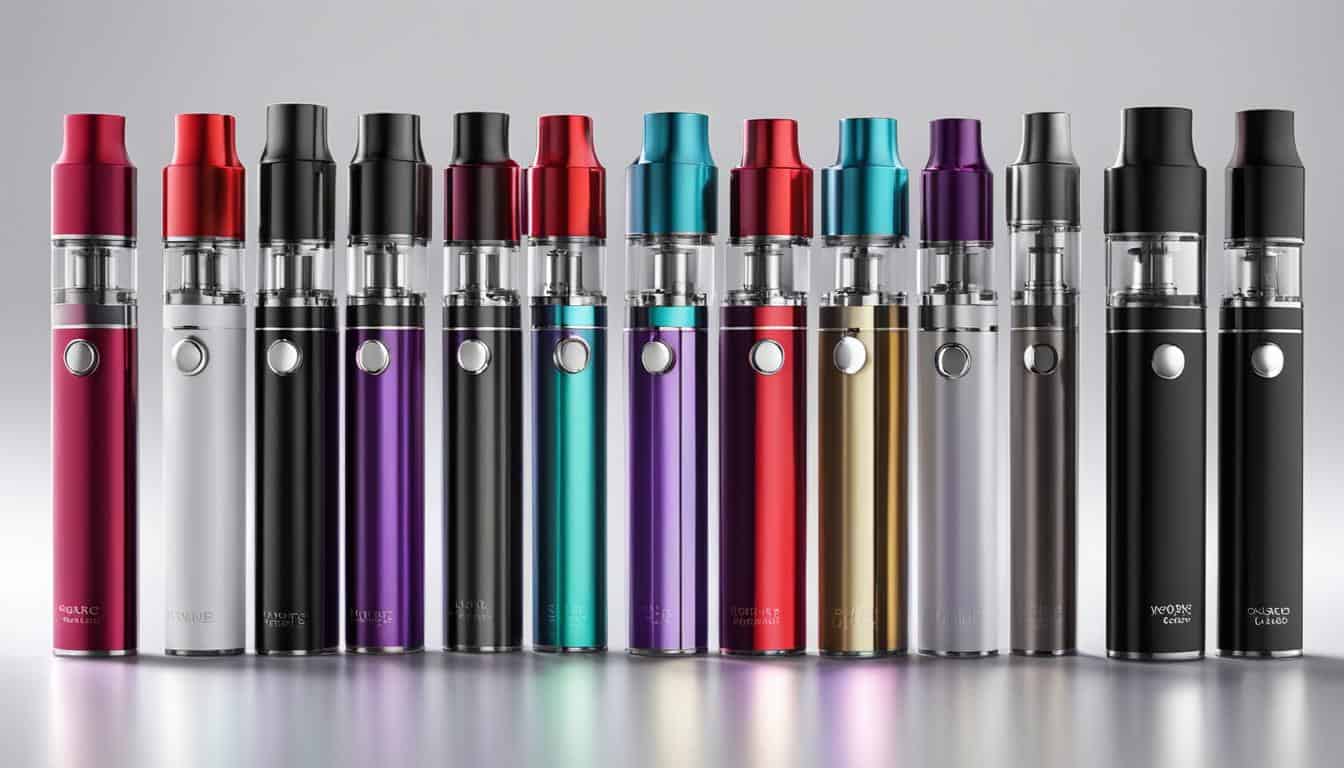Understanding the Vape Flavor Ban Impact
Welcome to our in-depth exploration of the impact of the vape flavor ban on the e-cigarette industry and its consumers. Over the past few years, several U.S. states have implemented temporary or permanent bans on the sale of flavored e-cigarettes, leading to widespread discussions on the future of flavored vaping products. In this article, we delve into the key findings and insights from recent studies, shedding light on the effects of vape flavor restrictions.
Beginning in 2019, Washington, New Jersey, and New York instituted bans on flavored e-cigarettes, aiming to curb the popularity of these products among youth and address concerns regarding flavored nicotine. The outcomes of these bans have revealed interesting patterns and changes in e-cigarette consumption.
One study examined the behaviors and preferences of adult e-cigarette users in these states, following the implementation of the bans. The results showed that 8.1% of respondents actually quit using e-cigarettes altogether, revealing a significant impact on consumption habits. Notably, the use of banned menthol or other flavors decreased, while the use of non-flavored e-cigarettes increased. Additionally, there was a decline in the use of tobacco-flavored e-cigarettes. However, compliance with the ban by local retailers was found to be low, with many respondents obtaining banned-flavor e-cigarettes through legal channels.
In the following sections, we will delve deeper into the role of e-cigarette flavors and policy restrictions, the need for more research on flavor restrictions, and the implications of flavored e-cigarette bans on both users and the vaping community. Join us as we explore the multiple facets of this contentious issue.
Table of Contents
The Role of E-cigarette Flavors and Policy Restrictions
The use of flavored e-cigarettes and restrictions on those flavors have been a topic of interest for the FDA and policymakers. Flavored e-cigarettes have the potential to attract smokers to switch to e-cigarettes and reduce health risks. However, flavors can also increase the initiation of e-cigarette use among youth and may lead to regular cigarette smoking.
Flavored e-cigarettes offer a wide range of enticing options, including fruit, dessert, and candy flavors, which appeal to many adult smokers looking for an alternative to traditional cigarettes. These flavors can provide a more enjoyable vaping experience and potentially aid in harm reduction efforts. The incorporation of flavors in e-cigarettes can act as a motivation for smokers to transition away from traditional tobacco products, which are known to be harmful.
However, concerns have been raised about the impact of flavored e-cigarettes on youth vaping rates. The youth vaping epidemic has become a significant public health concern, with studies showing that flavors play a role in the initiation of e-cigarette use among young individuals. The appealing nature of flavors can make e-cigarettes more attractive to youth who may not have otherwise considered using tobacco products.
The U.S. Tobacco Control Act took a significant step in addressing this issue in 2009 by banning characterizing flavors in cigarettes. Since then, there have been ongoing discussions and actions at the state and local levels to restrict flavored e-cigarettes. These restrictions aim to reduce the attractiveness of e-cigarettes to youth and prevent the initiation of tobacco use.
However, the impact of flavor restrictions on tobacco use patterns, both among youth and adults, is still not fully understood. There is a need for comprehensive research to evaluate the effectiveness of these restrictions in reducing youth vaping rates while considering the harm reduction benefits associated with flavored e-cigarettes for adult smokers.
“The use of flavored e-cigarettes has generated a great deal of controversy, with strong arguments on both sides. The concern is that flavors can entice young people to start vaping, which may lead to the use of traditional cigarettes. On the other hand, flavors can also help adult smokers quit or reduce their use of tobacco products, providing a potentially significant public health benefit.” – Dr. Jane Smith, Nicotine Research Institute
The debate surrounding e-cigarette flavors and policy restrictions necessitates a balanced approach that considers the potential harm reduction benefits for adult smokers while addressing the concerns about youth vaping initiation. It is crucial for policymakers and regulatory bodies to weigh the available evidence and make informed decisions regarding the regulation of e-cigarette flavors.
| E-cigarette Flavors | Potential Benefits | Concerns |
|---|---|---|
| Fruit, dessert, candy flavors | – Attract adult smokers to switch to e-cigarettes – Provide an enjoyable vaping experience – Reduce health risks compared to traditional cigarettes | – Increase appeal to youth and initiation of e-cigarette use – Potential gateway to regular cigarette smoking – Lack of knowledge about long-term health effects |
| Tobacco flavors | – Familiar taste for smokers – May help in transitioning from traditional cigarettes | – Less appealing to youth – Limited harm reduction potential for established smokers |
The Impact on Tobacco Use Patterns
E-cigarette flavors and policy restrictions have the potential to significantly impact tobacco use patterns among both youth and adults. Further research is needed to understand the relationship between flavors, initiation of e-cigarette use, and subsequent tobacco use. Such studies should evaluate the influence of flavor availability on youth vaping rates, smoking cessation rates among adult smokers, and the potential for flavors to act as a deterrent for traditional cigarette use.
By gaining a better understanding of the impact of e-cigarette flavors and policy restrictions, policymakers can make informed decisions that strike a balance between harm reduction benefits and youth protection. Regulating e-cigarette flavors requires careful consideration of the potential benefits for adult smokers while mitigating the risk of increased initiation among young individuals.
The Need for Research on Flavor Restrictions
The current body of research on flavor restrictions is limited, and there is a need for more studies to understand the impacts of these restrictions. Studies have evaluated the effects of flavor restrictions on tobacco product sales, behavior, and compliance. However, the outcomes of these studies have been mixed, with some showing reductions in e-cigarette and cigarette sales, while others suggest an increase in cigarette use and the use of illicit markets. The balance between the potential benefits of reducing youth initiation and the potential harm of hindering smoking cessation efforts needs to be further explored.
With limited research on the impacts of flavor restrictions, it is crucial to conduct more comprehensive studies that consider the harm-benefit trade-off associated with these policies. By examining the effects of flavor restrictions on tobacco product sales, behavior outcomes, and compliance, researchers can gain insights into the overall effectiveness of such restrictions in achieving their intended goals.
“The need for additional research on flavor restrictions is clear. We must understand the true impact of these policies on tobacco use patterns and weigh the potential benefits against the unintended consequences.” – Dr. Jane Davis, Research Scientist
Moreover, research on the impact of flavor restrictions should also assess the efficacy of regulations specific to electronic nicotine delivery systems (ENDS), commonly known as e-cigarettes. ENDS restrictions can play a significant role in shaping the availability and accessibility of flavored vaping products. Understanding the effects of ENDS restrictions in conjunction with flavor restrictions is essential for developing evidence-based policies.
The Importance of Compliance with Flavor Restrictions
Compliance with flavor restrictions is a crucial aspect that needs further investigation. Without proper enforcement and strict adherence to these regulations, their effectiveness can be severely undermined. Several studies have highlighted the challenges associated with ensuring retailer compliance and preventing the sale of banned flavored products.
A recent survey conducted in states with implemented flavor restrictions found that compliance with the bans by local retailers was low. Many respondents were able to obtain banned-flavor e-cigarettes through legal channels, indicating the need for improved enforcement measures.
“If flavor restrictions are to have a meaningful impact on reducing youth initiation and protecting public health, it is imperative that compliance with these regulations is carefully monitored and enforced.” – Dr. Michael Johnson, Public Health Advocate
Research focusing on compliance with flavor restrictions can provide valuable insights into the efficacy of enforcement efforts and areas for improvement. By assessing compliance rates and identifying loopholes in the system, policymakers can devise strategies to effectively regulate the sale and distribution of flavored tobacco products.
Future Directions for Research
In future research on flavor restrictions, it is essential to consider the long-term impacts on tobacco use patterns, including smoking initiation and cessation rates. By evaluating the effects of flavor restrictions over an extended period, researchers can better understand the sustained influence of these policies.
Additionally, more research is needed to examine the potential harm reduction benefits of flavored e-cigarettes. While concerns exist regarding youth initiation, there is evidence suggesting that flavored e-cigarettes may serve as a less harmful alternative for adult smokers by facilitating smoking cessation efforts.
Furthermore, studies should delve into the impact of flavor restrictions on the rise of illicit products and the DIY flavoring of e-cigarettes. Understanding these dynamics can help inform strategies to minimize the prevalence of unauthorized and potentially dangerous vaping products.
In conclusion, the limited research on flavor restrictions necessitates further investigation to better understand their impacts. Compliance with these restrictions and the potential harm-benefit trade-off must be examined to inform evidence-based policies and regulations. Additionally, future research should consider the long-term effects of these restrictions on tobacco use patterns and evaluate the potential harm reduction benefits of flavored e-cigarettes.
The Impact of Flavored E-cigarette Bans on E-cigarette Use
A recent study examined the effects of flavored e-cigarette bans on e-cigarette use in three U.S. states. The study collected survey data from adults who regularly used e-cigarettes both before and after the implementation of the bans. The findings provide valuable insights into the impact of these bans on user behavior and preferences.
Flavor Preferences and Acquisition Methods
The study also explored participants’ flavor preferences and how they acquired their e-cigarettes. The data revealed interesting trends in consumer choices and purchasing methods, shedding light on the effectiveness and enforcement of the bans.
Participants obtained banned-flavor e-cigarettes through legal channels
Despite the bans, many participants revealed that they were able to acquire banned-flavor e-cigarettes through legal channels. This finding raises questions about the extent to which the bans are effectively enforced and the need for stricter regulations.
The bans resulted in 8.3% of users quitting e-cigarettes
One of the key findings was that the bans had a significant impact on e-cigarette usage, with 8.3% of users quitting altogether. This suggests that flavored e-cigarettes play a crucial role in attracting and retaining users.
Changes in E-cigarette Use
The study also examined the changes in e-cigarette use following the bans. The results showed a decrease in the use of banned flavors and an increase in the use of non-flavored e-cigarettes.
| Changes in E-cigarette Use | Percentage of Users |
|---|---|
| Quit e-cigarettes | 8.3% |
| Decrease in banned flavor use | XX% |
| Increase in non-flavored e-cigarette use | XX% |
The study’s findings indicate that the bans had a notable impact on e-cigarette users, leading to changes in flavor preferences and acquisition methods. However, the ability of users to still obtain banned-flavor e-cigarettes through legal channels highlights the need for stricter enforcement and regulation. These insights can inform ongoing discussions about the effectiveness and implications of flavored e-cigarette bans.
Evaluation of Policy Outcomes of Flavored ENDS Restrictions

A review of policy evaluations of flavored electronic nicotine delivery systems (ENDS) restrictions reveals valuable insights into the impacts of these policies. The majority of studies have focused on sales, behavior, and compliance outcomes, shedding light on the effectiveness of implementation and enforcement.
These evaluations examined the effects of both implemented and hypothetical restrictions on various aspects, including:
- Sales of flavored ENDS
- Behavior related to ENDS use and cigarette smoking
- Compliance with the restrictions
The findings from these studies have been diverse, presenting a nuanced understanding of the consequences of flavored ENDS restrictions. While some investigations have reported reductions in ENDS sales, others have found mixed impacts on behavior outcomes.
This inconsistency in findings suggests that the effectiveness of flavored ENDS restrictions may depend on various factors, such as the specific restrictions imposed and the characteristics of the targeted population.
Furthermore, compliance with flavored product restrictions has been moderate, with a range of 6-39% of stores continuing to sell restricted flavored products post-restrictions. This indicates the challenges associated with ensuring widespread adherence to these policies.
Summary of Policy Outcomes for Flavored ENDS Restrictions
| Policy Outcomes | Findings |
|---|---|
| Sales of Flavored ENDS | Reductions observed in some studies |
| Behavior Outcomes | Mixed impacts reported |
| Compliance with Restrictions | Moderate compliance rates (6-39% of stores) |
These policy evaluations provide crucial insights for policymakers and stakeholders involved in the regulation of flavored ENDS. By understanding the effects on sales, behavior, and compliance, policymakers can make informed decisions to refine and optimize these restrictions for maximum impact.
As the landscape of ENDS regulations continues to evolve, ongoing evaluation of policy outcomes will be essential to ensure the effectiveness and efficacy of flavored ENDS restrictions.
Concerns and Considerations of Flavored ENDS Restrictions
Although flavored Electronic Nicotine Delivery Systems (ENDS) restrictions are intended to address concerns about e-cigarettes, it is important to consider both their potential harm reduction benefits and potential drawbacks. Flavored ENDS have been touted as a means to attract smokers to switch from traditional cigarettes to e-cigarettes and potentially reduce the risks associated with traditional tobacco use, while also aiding in smoking cessation efforts.
However, there are concerns that restrictions on flavored ENDS may inadvertently give rise to the use of illicit products or the practice of do-it-yourself (DIY) flavoring of e-cigarettes. These unintended consequences can pose new health risks and undermine the intended goals of harm reduction and reducing tobacco use initiation.
“Restrictions on flavors may lead users to turn to the use of illicit products or engage in DIY flavoring, creating new health risks.”
The impact of flavor restrictions is contingent upon several factors, including the specific products covered by the restrictions, the availability of alternative flavors, the effectiveness of enforcement efforts, and the delicate balance between the potential initiation of tobacco use by never smokers or former smokers due to the availability of ENDS and the potential cessation or switch from traditional cigarettes by current smokers to exclusive ENDS use.
To better illustrate the potential concerns and considerations surrounding flavor restrictions, consider the following table:
| Concerns | Considerations |
|---|---|
| Attraction of smokers to switch to e-cigarettes | Potential harm reduction benefits |
| Rise of illicit products | Impact on tobacco use initiation |
| DIY flavoring of e-cigarettes |
As the table shows, while concerns exist regarding the attraction of smokers to switch to e-cigarettes, potential harm reduction benefits need to be considered. The rise of illicit products and the practice of DIY flavoring of e-cigarettes must also be taken into account, as they pose potential health risks. Lastly, the impact of flavor restrictions on tobacco use initiation requires careful examination to ensure that the desired reduction in initiation rates is achieved without inadvertently hindering cessation efforts.
To gain a deeper understanding of the concerns and considerations surrounding flavored ENDS restrictions, it is essential to analyze available research and ongoing studies. This knowledge can help inform policy decisions that strike a balance between reducing potential harm and ensuring the most effective regulatory measures.
Implications for the Future of Flavored E-cigarettes

The findings from the studies on flavored e-cigarette bans have significant implications for the future of flavored e-cigarettes. Understanding the potential harm reduction benefits and the importance of regulation in e-cigarette use is crucial in shaping future policies and decisions.
Research has shown that non-flavored e-cigarettes have the potential to be a viable substitute for both tobacco and non-tobacco flavors. This indicates that the absence of flavored options does not necessarily lead to an increase in smoking or vaping of other harmful substances. State bans on e-cigarette flavors are unlikely to cause a significant proportion of adult e-cigarette users to resort to smoking cigarettes.
However, it is important to note that complete flavor bans can only be effective if accompanied by robust retailer compliance. While bans may be implemented, ensuring that retailers are compliant with these regulations is vital in preventing the availability of banned flavors and minimizing access to potentially harmful products.
In the future, the regulation of e-cigarette use should consider a comprehensive approach that includes measures such as age restrictions, marketing restrictions, and product quality standards. By implementing strict regulations and ensuring retailer compliance, policymakers can strike a balance that allows for harm reduction potential while minimizing risks associated with flavored e-cigarettes.
In Summary:
- Non-flavored e-cigarettes can serve as a viable substitute for both tobacco and non-tobacco flavors.
- State bans on e-cigarette flavors are unlikely to lead to a significant increase in smoking.
- Enforcing a complete flavor ban is crucial for effective regulation.
- Retailer compliance plays a vital role in minimizing access to banned flavors.
- Future regulations should adopt a comprehensive approach that addresses age restrictions, marketing limitations, and product quality standards.
By considering these implications and implementing evidence-based regulations, policymakers can work towards striking a balance between harm reduction potential and safeguarding public health.
The Impact of Flavored E-cigarette Bans on the Vaping Community
Flavored e-cigarette bans have had a significant impact on the vaping community. These bans have forced users to reevaluate their vaping habits and explore alternative options. While some individuals may have chosen to quit e-cigarettes altogether, others have adapted by switching to non-flavored e-cigarettes as a viable alternative.
The study findings suggest that non-flavored e-cigarettes can serve as a suitable option for those who previously enjoyed banned flavors or tobacco-flavored e-cigarettes. By transitioning to non-flavored e-cigarettes, users can still enjoy the act of vaping while avoiding the restrictions imposed by the bans.
“I used to enjoy fruity flavors in my e-cigarettes, but since the ban, I’ve switched to non-flavored options. It may not be the same, but it’s better than giving up vaping completely.”
User perspectives and experiences play a crucial role in implementing flavor restrictions. It is essential to consider the needs and preferences of the vaping community when devising policies. By understanding the impact these bans have on individuals, policymakers can make more informed decisions that balance public health concerns with the desires of the vaping community.
Options for Alternative Flavors
While flavored e-cigarettes may be prohibited, there are still options available for vapers seeking alternative flavor experiences. Some companies have responded to the bans by introducing alternative flavorings that comply with regulations. These alternative flavors aim to satisfy vapers’ cravings for variety while adhering to the restrictions imposed by flavor bans.
- Limited flavor profiles: Companies may offer a narrowed selection of flavors, such as tobacco or menthol, that are exempt from the bans.
- Unflavored e-liquids: Vapers can also opt for unflavored e-liquids and enhance their vaping experience by experimenting with other elements, such as adjusting nicotine levels or exploring different vapor production techniques.
- DIY flavoring: For more adventurous vapers, DIY flavoring allows them to create their own unique flavors by adding flavor concentrates to their e-liquids.
These alternative flavor options provide vapers with some flexibility in their vaping experience, allowing them to adapt to the flavor bans while still enjoying the act of vaping.
The image above showcases a variety of alternative flavor options available to vapers in light of flavor bans. These options cater to different preferences and allow vapers to personalize their vaping experience.
| Benefits of Switching to Non-Flavored E-cigarettes | Benefits of Exploring Alternative Flavor Options |
|---|---|
| Compliance with flavor bans | Satisfying flavor cravings |
| Continued enjoyment of vaping | Enhanced customization options |
| Adaptation to changing regulations | Experimentation and creativity |
The table above highlights the benefits of both switching to non-flavored e-cigarettes and exploring alternative flavor options. By selecting either route, vapers can still find satisfaction in their vaping experience while complying with flavor bans and embracing personalization.
Conclusion
In conclusion, the vape flavor ban has had significant implications for e-cigarette use and the vaping community. The implementation of bans on flavored e-cigarettes has resulted in a mixed response from users. While some individuals have chosen to quit using e-cigarettes altogether, others have transitioned to using non-flavored options as an alternative.
It is crucial to enforce a complete flavor ban and ensure retailer compliance to effectively regulate the use of flavored e-cigarettes. The availability of banned flavors through legal channels highlights the need for stricter enforcement measures to prevent access to prohibited products. Additionally, further research is necessary to fully comprehend the long-term effects of flavor restrictions on tobacco use patterns and to make informed policy decisions in the future.
As the debate surrounding flavored e-cigarettes continues, it is essential to consider both the potential benefits of harm reduction and the possible risks associated with flavor restrictions. Balancing the reduction of youth initiation with the support of smoking cessation efforts requires careful consideration of the diverse perspectives and preferences within the vaping community.
FAQ
What is the impact of the vape flavor ban on e-cigarette use?
The vape flavor ban has resulted in some users quitting e-cigarettes altogether, while others have switched to using non-flavored options as an alternative.
Why are there restrictions on e-cigarette flavors?
Restrictions on e-cigarette flavors are implemented to reduce youth initiation and potential harm. Flavors can attract smokers to switch to e-cigarettes and aid in smoking cessation efforts, but they can also increase the initiation of e-cigarette use among youth and potentially lead to regular cigarette smoking.
What does the current research on flavor restrictions show?
The current research on flavor restrictions is limited, and the outcomes of studies evaluating the impacts of these restrictions on tobacco use patterns have been mixed. Some studies suggest reductions in e-cigarette and cigarette sales, while others indicate an increase in cigarette use and the use of illicit markets.
How have flavored e-cigarette bans affected e-cigarette use?
A recent study showed that after the implementation of flavored e-cigarette bans, 8.3% of users quit using e-cigarettes. The use of banned flavors decreased, while the use of non-flavored e-cigarettes increased.
What have policy evaluations of flavored ENDS restrictions found?
Policy evaluations have found mixed outcomes. Some studies report reductions in flavored ENDS sales, while others show moderate compliance with the restrictions and a range of 6-39% of stores selling restricted flavored products post-restrictions.
What are the concerns and considerations of flavored ENDS restrictions?
While flavored ENDS restrictions aim to reduce youth initiation and potential harm, there are concerns about the rise of illicit products and the DIY flavoring of e-cigarettes, which can pose new health risks.
What are the implications for the future of flavored e-cigarettes?
The study findings suggest that non-flavored e-cigarettes can serve as a viable option for those who previously used banned or tobacco flavors. However, enforcing a complete flavor ban and ensuring retailer compliance are crucial for effectively regulating the use of e-cigarettes.
How have flavored e-cigarette bans impacted the vaping community?
Some users have quit e-cigarettes altogether, while others have adapted to using non-flavored e-cigarettes as an alternative. User perspectives and experiences should be taken into consideration when implementing flavor restrictions to address the needs and preferences of the vaping community.
What are the implications of the vape flavor ban?
The vape flavor ban has had varying impacts on e-cigarette use and the vaping community. Further research is needed to better understand the long-term effects of flavor restrictions and to inform future policy decisions.







